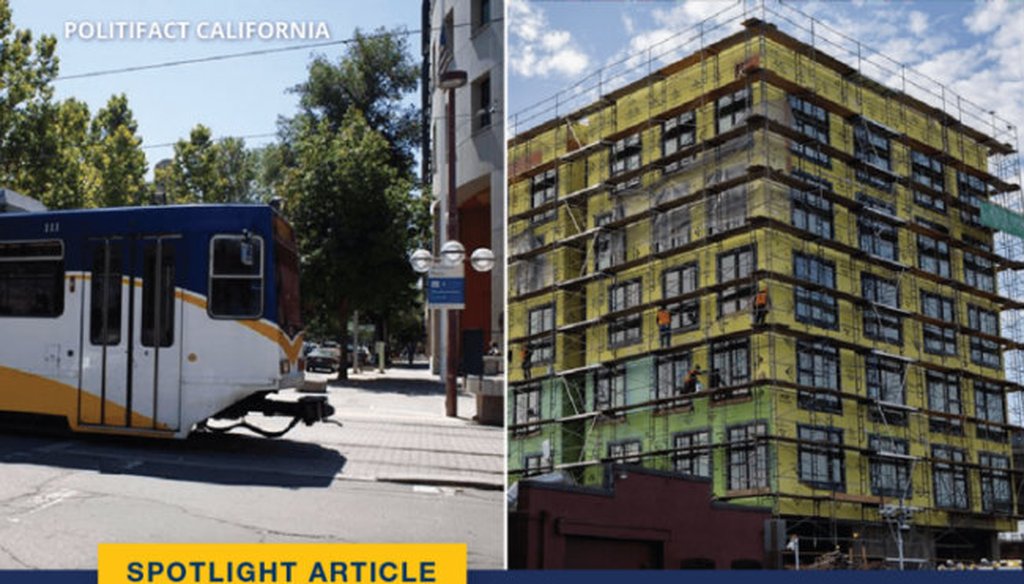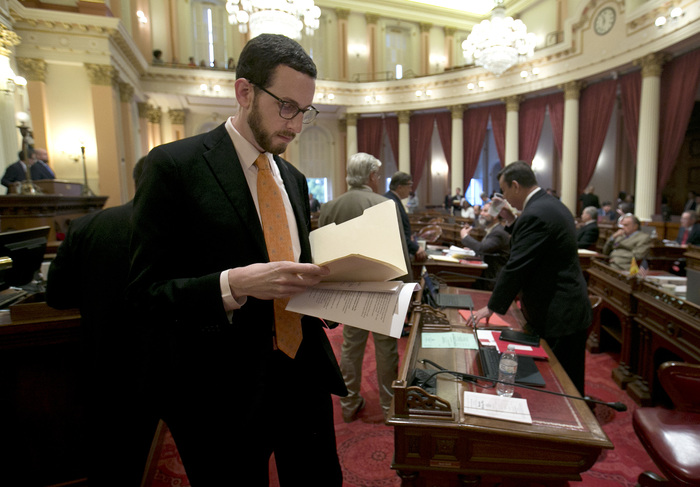Stand up for the facts!
Our only agenda is to publish the truth so you can be an informed participant in democracy.
We need your help.
I would like to contribute

California's Senate Bill 50 would allow cities to boost housing density near transit and job centers.
When one of the most contested California housing bills in years resurfaced at the state Capitol this month, so did the heated, often exaggerated claims about how it would ease the state’s affordable housing crisis — or possibly make it worse.
Senate Bill 50, authored by Democratic state Sen. Scott Wiener of San Francisco, would require cities and counties to allow higher-density housing near job and transit centers. Most new units would be priced at the market rate, but the bill requires up to a quarter to be affordable.
In neighborhoods within a half mile of rail stations, ferry terminals and other transit hubs, this "upzoning" would greenlight mid-rise apartment towers of four or five stories. In spots farther from transit and jobs, it would permit dividing homes into duplexes, triplexes and fourplexes in areas previously zoned for single-family homes.
The bill has failed in previous years. But Wiener made a significant change to the legislation this month: giving local governments two years to come up with plans for increasing density while still meeting the goals of boosting housing production near jobs and transit.
And the clock is ticking for SB 50; it must pass the full Senate by January 31 to move forward this year.
Sign up for PolitiFact texts
That’s not a certainty, as SB 50 continues to face strong opposition from a variety of coalitions, including anti-gentrification groups and suburban communities worried it will transform neighborhoods into unaffordable, dense population districts.
In the meantime, claims about SB 50 continue to fly — at demonstrations, speeches and on social media — and many are oversimplified or taken out of context.
Supporters maintain that by boosting supply of new market-rate housing, the bill will help drive down California’s exorbitant housing costs.
But critics say it would spur "luxury" condos and apartments, displace low-income renters and is not an affordable housing solution, as supporters claim.
PolitiFact California wanted to know: Who’s telling the truth?
We spoke with the bill’s author and housing experts to help separate fact from fiction.
Wiener made this claim to reporters after announcing the relaunch of SB 50 in Oakland earlier this month.
"This will create more of every kind of housing because we need more subsidized housing for low-income people," he said. "But we need more market-rate housing to bring down prices for people in the middle class."

State Sen. Scott Wiener, D-San Francisco, at the Capitol in April 2017, in Sacramento, Calif. (AP Photo/Rich Pedroncelli)
Housing experts don’t dispute the idea that SB 50 would lead to greater supply. They say high-paying jobs are increasingly concentrated in the state’s urban cores near mass transit. And there’s strong demand for more housing in those areas from upper-income earners.
But the experts say the prediction about prices dropping for the middle class is oversimplified and not likely to materialize, unless many other conditions are met.
"Increasing the supply could under some circumstances moderate some of the price pressures in some markets, but it's by no means guaranteed," said Alex Schwartz, a professor of urban policy at the New School in New York.
Much would depend on the kind of housing built. If most of it is "hyper-luxury housing," Schwartz said that will do little to lower prices for the middle class.
If more moderately priced housing is built, prices could decrease somewhat as owners vacate their older apartments, providing more affordable units for those who earn less.
He said achieving an overall drop in prices also assumes California’s population stays constant. Growth has slowed in the state, but not completely.
Potential for 'less extreme increases'
Robert Silverman, professor of urban and regional planning at the University of Buffalo, said the most optimistic scenario would be for housing prices to stabilize.
"I wouldn’t expect housing prices to decrease in California under that scenario," Silverman wrote in an email. "At best, you may see less extreme housing price increases if a significant number of units were added to the inventory."
In a follow-up interview last week, Wiener acknowledged SB 50 would not provide "an overnight change." He said, however, that "increasing the supply of market rate housing, over time, will reduce costs."
As evidence, his office cited a report released this month by the Upjohn Institute, an independent research group. The report finds that "new market-rate apartment buildings in low-income areas do not accelerate gentrification," and instead that "they slow rent increases in nearby apartments and increase the number of people who move into the area from other low-income Neighborhoods."
The report went on to note that, under certain scenarios, new apartment buildings could decrease rents by 5 to 7 percent in a neighborhood "relative to what rents would be had the building not been constructed—our finding does not mean that rents decreased in absolute terms."
Even with much more new supply, Schwartz agreed there won’t be a dramatic decrease in housing prices for the middle- or working-class for years. "And you may not see any change at all."
"This is a mismatch between income and housing costs and marginal changes are not going to make a dent on this problem," he said. "The need is for subsidy not just for increased market rate housing."
In the end, the experts agreed that under certain scenarios, the growth in housing prices could start to stabilize with more market-rate supply. But that’s not the same thing as bringing those prices down.
Critics such as Housing Is A Human Right, a housing advocacy division of the AIDS Healthcare Foundation, have repeatedly described SB 50 as a "luxury housing bill."
"It’s still a gentrification machine. It still favors new luxury units," wrote Livable California, another group opposed to SB 50, in a list of talking points it distributed this month.
Michael Storper, an urban planning professor at UCLA, said there’s some truth to those criticisms. Storper has spoken out against what he calls the bill’s "deeply flawed" analysis of what it would take to solve the state’s housing affordability crisis.
He told us SB 50 would spur new supply, but mainly for the rich.
Developers, with the goal of making the most profit possible, would target wealthy areas and "produce housing at price points that are only accessible to higher-income people," he said.
Storper added that existing zoning in California already allows for millions more potential housing units, but developers only build in areas that pencil-out.
Wiener rejects the idea that SB 50 is a "luxury housing bill," noting it requires up to 25 percent of new projects be set aside for affordable housing.
"To describe SB 50 as a ‘luxury housing bill’ is just flat out wrong," he said. Opponents are conflating housing that’s expensive due to scarcity with luxury housing, two different things, Wiener said.
This claim is accurate — but doesn’t tell the whole story.
Requiring parking can add significantly to building costs, which drives up rents. SB 50 blocks local governments from forcing developers to meet typical parking standards, particularly near rail. If the project is built within a quarter-mile of a rail station in a city with a population greater than 100,000, "it shall receive a waiver from any minimum automobile parking requirement," according to the current language in the bill.
"It does not prevent developers from putting parking in if they think that is appropriate for their project," Wiener explained.
This claim is also generally correct, but ignores how legislation works. Counties with fewer than 600,000 people — including wealthy areas such as Marin, Sonoma, Santa Cruz and Santa Barbara — will only be asked to allow one extra story of housing near rail stations on top of their existing standards. They will also have to permit four-plexes countywide, according to Wiener.
But they won’t have to permit the four- to five-story apartment buildings required in larger counties.
"It is completely inaccurate to say [smaller counties] have been excluded from the bill. They are in the bill. The bill applies to them. The bill was amended to provide a lighter touch to small counties," Wiener added.
He said he wanted to treat all counties the same, but the change was part of a compromise in a Senate committee last year to move the bill forward.
"I’m not a dictator," Wiener said. "I don’t get to just pronounce what bills pass the Legislature. I have to go through committees."
SB 50’s Future
Late last week, state Senate pro-tem Toni Atkins announced SB 50 would return to the Senate Rules Committee. The bill was held in the Senate Appropriations committee last year.
Atkins said in a news release the move should give all sides more time to work on the bill before its January 31 deadline to pass the full Senate.
"While many communities still have clear concerns about SB 50, our affordable housing crisis demands we make every attempt to reach agreement on potential solutions," Atkins said. "I hope the additional time afforded by this action contributes to the ongoing efforts being made by Senator Wiener, housing advocates, and community leaders."
With debate over SB 50 intensifying once again, we’ll continue to track the bill and the accuracy of the arguments made for and against it.
Email us at politifactca@capradio.org with feedback or contact us on Twitter or Facebook.
Also, we’re starting a new project called ‘Ask PolitiFact California.’ Is there something in California government or politics that we should fact-check next? Send us a question, and one of our reporters and fact-checkers might reach out to find the answer.
Our Sources
California State Sen. Scott Wiener, press conference, Jan. 7, 2020 and phone interview Jan. 15, 2020
Senate Bill 50, text, accessed January 2020
Alex Schwartz, professor of urban policy, The New School, phone interview, Jan. 16, 2020
Michael Storper, professor of urban planning, UCLA, phone interview, Jan. 16, 2020
Robert Silverman, professor of urban and regional planning, University of Buffalo, email interview, Jan. 17, 2020
Upjohn Institute, Supply Shock versus Demand Shock, Jan. 10, 2020
Housing Is A Human Right, press release, Dec. 17, 2019
Livable California, 7 TALKING POINTS against SB 50, accessed January 2020
CapRadio, Demonstrators Protest SB50 As California Lawmakers Reintroduce Controversial Housing Law, Jan. 7, 2020
PolitiFact, The facts on housing affordability in the United States, Dec. 30, 2019
Los Angeles Times, High-profile California housing bill clears hurdle after tense debate over local control, April 24, 2019
Voice of San Diego, Sacramento Report: What's Next for SB 50, Nov. 1, 2019
California State Senate Leader Toni Atkins, Leader Atkins Statement on SB 50 Returning to Senate Rules Committee, Jan. 17, 2020






















































